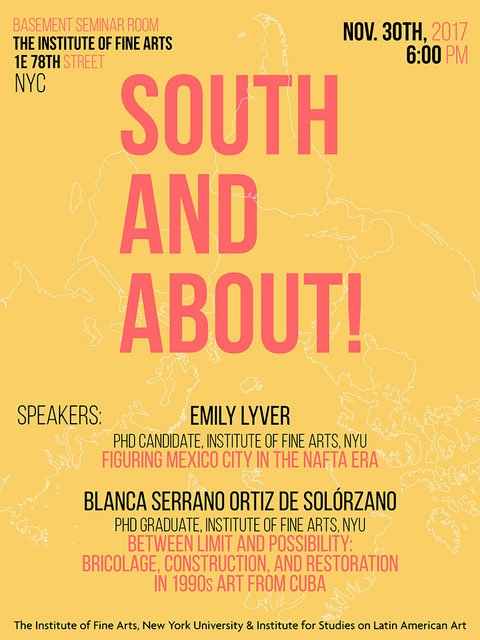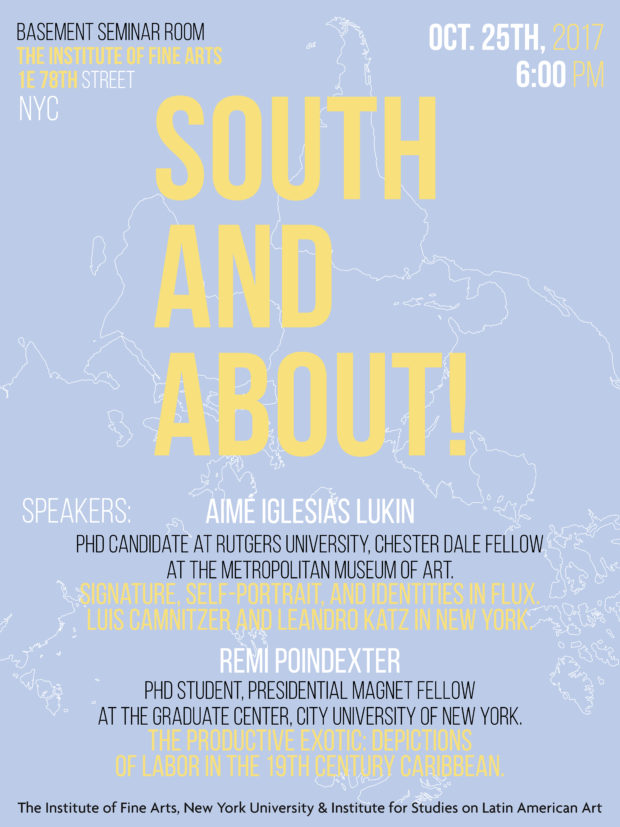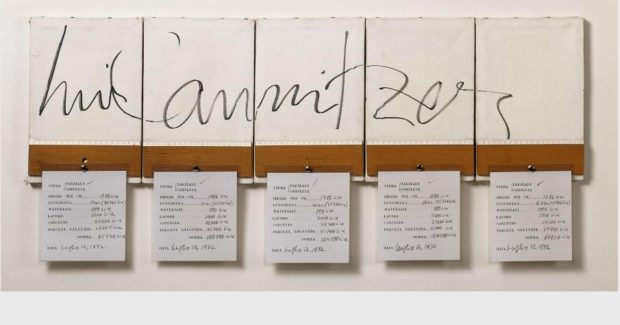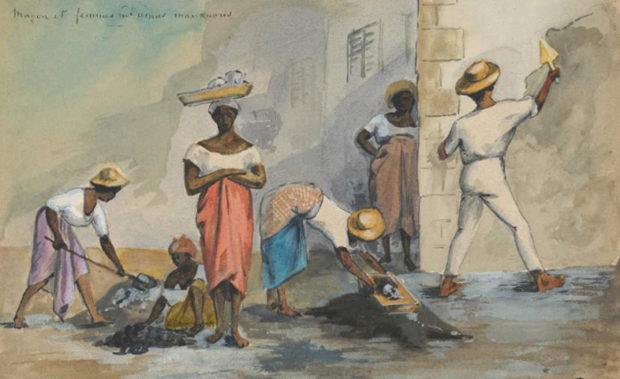South and About! Fall 2017
Thursday, November 30

Between Limit and Possibly: Bricolage, Construction, and Restoration in 1990s Art from Cuba
Blanca Serrano de Solórzano, Ph.D. Graduate, Institute of Fine Arts, NYU
This presentation will be an open discussion about how to turn a dissertation into both an article, and a book. The dissertation studies the examination by contemporary Cuban artists of the role, the purpose, and the meaning of art making during the 1990s, at a time when the Marxist-Leninist nation first undertook several market economy initiatives. Often known as the Special Period in Time of Peace, this decade was marked by the severe economic recession that impacted the island after the final fall of the Soviet Bloc in 1991. Within this critical context, many artists in their work from that decade explored other careers that were related to both manufacturing and the visual arts. Adopting the role of designers, masons, and archeologists, among other occupations, these artists engaged with bricolage, construction, and restoration practices in their oeuvre. This project contemplates how the artists’ evaluation of their own trade through their pursuit of different crafts involved a reflection on what should be recuperated, preserved, and built within the revolutionary project.
Figuring Mexico City in the NAFTA Era
Emily Rose Lyver, Ph.D. Candidate, Institute of Fine Arts, NYU
In the late 1980s and throughout the 1990s, as Mexico enters a new era of economic liberalization epitomized by the North American Free Trade Agreement, young artists working in the proliferating alternative art spaces in Mexico City develop a politically-engaged conceptual practice that comes to prominence as the dominant style of artwork shown abroad, particularly in the United States.
In looking at artwork and exhibitions in Mexico and the U.S., in this period, I will explore the change in taste from Neo-Mexicanist painting—with its reimagined nationalist and folkloric tropes—to one that still engages with an image of Mexico, but in large part figures it as precarious, corrupt, and dangerous. I will consider how the narrative of a chaotic Mexico rose to prominence as Mexico made an entry both in the international art world and the global economy more generally.
Wednesday, October 25

Signature, Self-Portrait, and Identities in Flux
Aimé Iglesias Lukin, Ph.D. Candidate in Art History, Rutgers University

My presentation will explore the problem of signature, self-portrait, and authorship in works by Luis Camnitzer and Leandro Katz. Although signature was widely explored by artists and writers during the 1960s—the era of the “death of the author,” as described by Roland Barthes—my presentation will argue that the questioning of authorship took on particular relevance when explored by artist migrating to the big city from the so-called periphery. For the conceptual artists explored in this paper, signature not only became a way to question the idea of art and to propose institutional critique, but also served as a tool to discuss the authoritative role of European and US cultures and, in so doing, to review their identities in flux.
The Productive Exotic: Depictions of Labor in the 19th Century Caribbean
Remi Poindexter, Ph.D. Candidate in Art History, CUNY – Graduate Center

Stemming from the preliminary stages of a potential thesis project, this presentation explores different images of labor in the nineteenth century Caribbean.
Depictions of the laboring figure are relatively sparse in Caribbean works. In large oil paintings, figures usually occupy a very tiny space in compositions—serving mostly as staffage to mark scale and place. In works on paper, often in conjunction with travel narratives, such figures are far more present, providing illustrations of daily life and native “types” in distant locales. The vast majority of nineteenth century works depicting the Caribbean are by artists from Europe or the United States, therefore questions of perception and exoticism immediately come to mind.
In this talk I will look at images from various sources, examining how their respective formats and media impact their meaning. I will also look specifically at the figure of the washerwoman as a frequently chosen subject, whose sexual undertones are often beyond implicit. Finally, I will end with a discussion of illustrated travel journals, a popular nineteenth century genre that I am currently exploring.